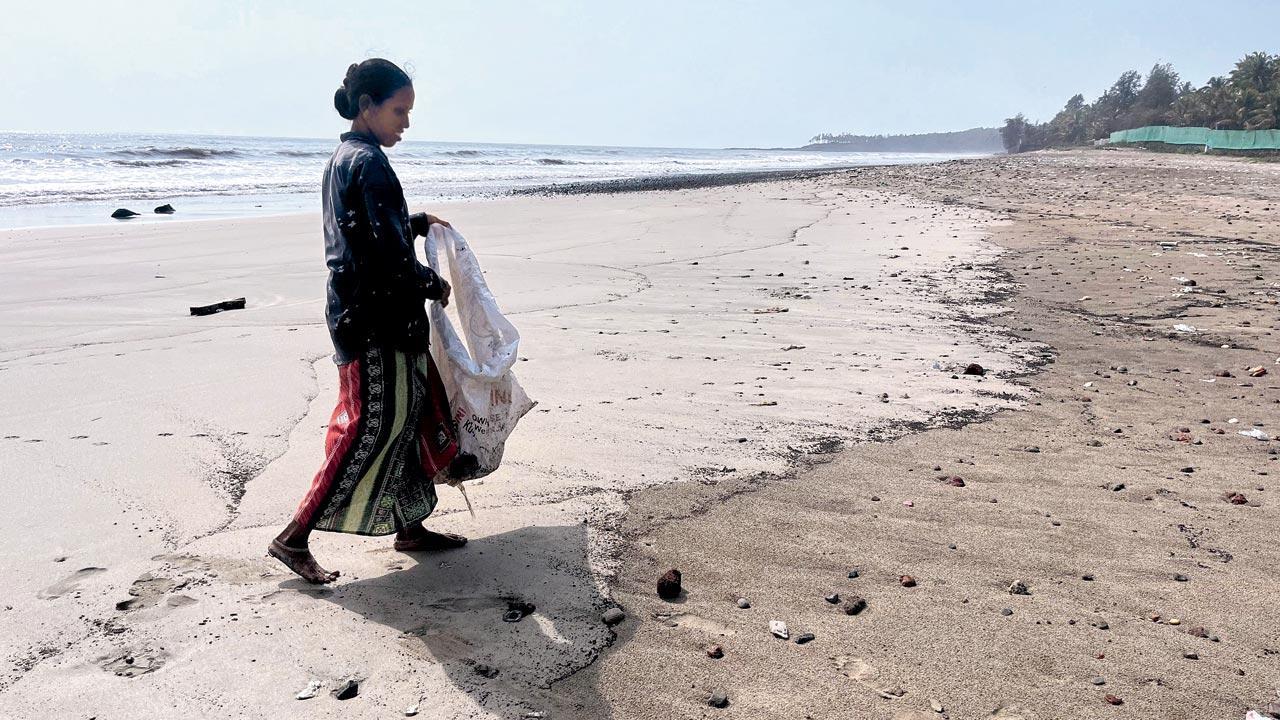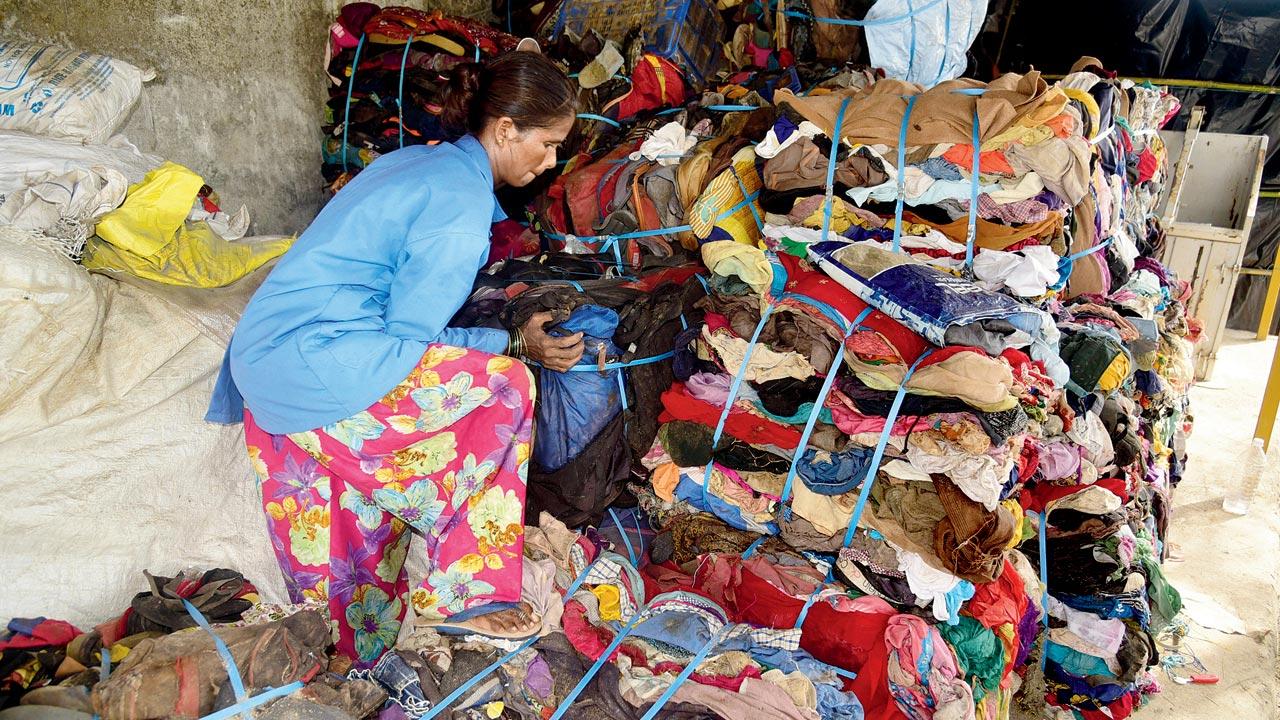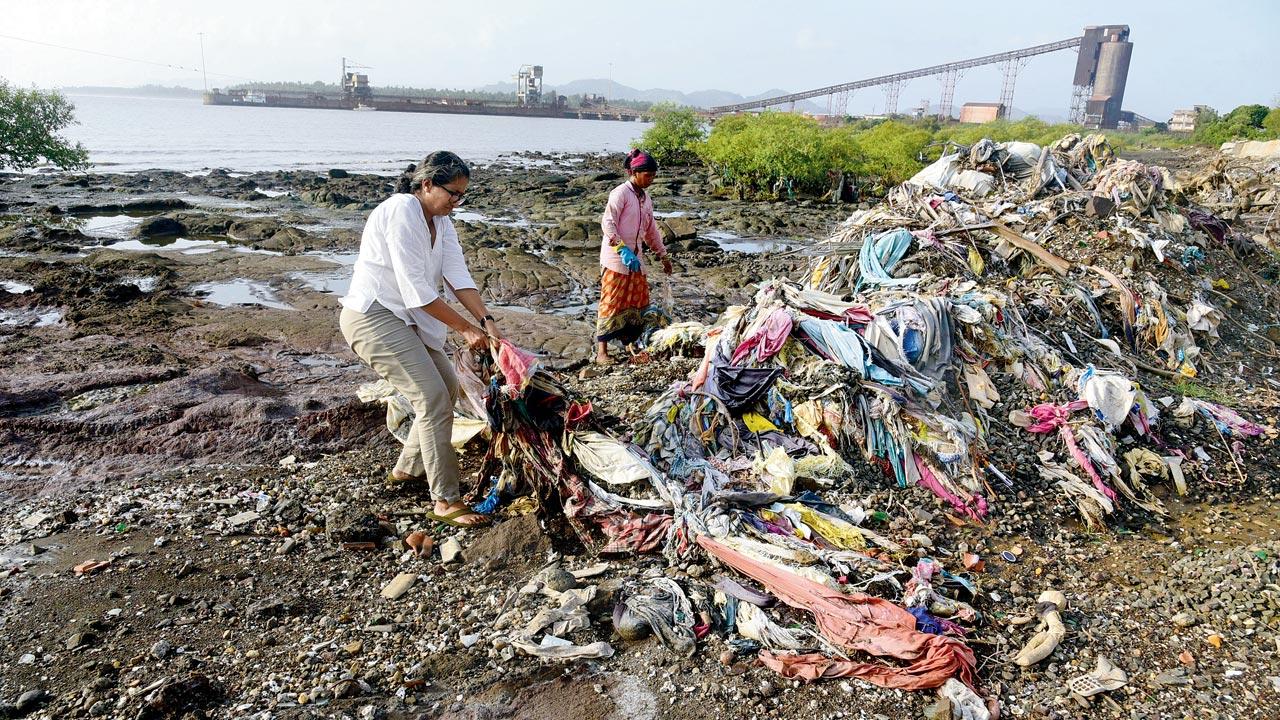mid-day takes a ferry to Alibaug, now a tony second home cluster, to talk trash with Rosalind Pereira and the Safai Saathi female army

Before Project Amhi’s Safai Saathis picked and segregated garbage, washed up waste was swept into a mound periodically and burnt leading to air pollution. Pics/Atul Kamble
Alibaug. Our own Hamptons (if your pincode halts at 400018). The wide expanse of the silver sands at Kashid beach. And here, the bank of trash the high tide washed in: rubber footwear, thermocol, packets of chips and a kurta. Project Amhi’s Safai Saathis will pick up all of this in the course of the day, take it to the 10-guntha plot loaned to them by the panchayat and sort the waste into 11 categories. Each burlap sack or goni will then be sent to a respective recycling centre as far away as Khopoli or Palghar.
ADVERTISEMENT
In the absence of this citizen endeavour—mostly by Mumbai residents with second homes by the seaside—this garbage would be collected and dumped in ad-hoc landfills, which is any dent in the ground between villages; or burned at the side of the road risking wildfires and assuring air pollution.
Project Amhi began its guerilla garbage collection tactics in 2021, when Rosalind Pereira and her family moved to their home in Nandgaon to sit out the pandemic like many Mumbaikars. Then she noticed the plumes of fumes on the seafront her patio overlooks. Waste would just be swept into a mound and lit.
 Nineteen women earn Rs 300 daily to clean up 10 villages every day
Nineteen women earn Rs 300 daily to clean up 10 villages every day
“We first started collecting garbage in Nandgaon and then moved on to Kashid in six months,” says the co-founder. She was soon joined by Hansu Pardiwala within a few months, who has a background in waste management; and Kiran Patel, another conscientious resident.
The challenge is to get people to segregate the waste into wet and dry, at source. Ironically, it was enforcement of this step in Navi Mumbai that won the satellite city the badge of being the third cleanest city in the country. The Navi Mumbai Municipal Corporation (NMMC) refused to collect garbage if it was not segregated.
By 2023, the model has developed to cover 19 Safai Saathis—all women—collecting garbage and sorting it at the above centre. They cover 10 villages every day—from Vihur to Korlai up until the Revdanda bridge. Two supervisors Naina Thakar and Sameer More oversee the operations and maintain data about the garbage collected—two tonnes of compressed clothes over the last five months, two to three tonnes of rubber footwear transported to a recycling centre in Pune at a cost of Rs 13,500 where they will sell for R4 per kilo (bringing in about R9,000). At the centre, the shoe’s sole is separated from the upper, and the former is turned into a foam material while the nylon is recycled into another raw material. Plastic is melted and turned into non-food grade items such as trash bins.
 Safai Saathis collect and segregate the waste into 11 categories and send them to respective centres for upcycling or recycling
Safai Saathis collect and segregate the waste into 11 categories and send them to respective centres for upcycling or recycling
“We reached out to women through self-help groups that would meet in the evening because women are tasked with home management,” says Pereira, who runs the handmade craft jewellery brand Maya Bazaar. Getting them on board was simple: “We offer regular and timely pay, sanitation equipment, regular hours and respect,” says Pereira, “and we do the job we expect them to do.” For the training sessions on segregation, Pereira and some neighbours put on their gloves, emptied the burlap sacks and extracted the dry waste from the wet. The women earn R300 for a day’s work. There has been a conscious decision to divide the cost among the residents and not rely on donations, since fundraising then becomes a dedicated job with a person on the payroll.
Pet and glass bottles are the coveted treasures of the burlap sack—raddiwaalas rush to collect them as they sell at Rs 20 per kilo. Low-density polyethylene (LDPE) like plastic packets, in comparison, draws only Rs 2 per kilo. Multi-layered plastic (MLP) which keeps potato chips crunchy and bhujia brittle, is the hardest to recycle—it has to be sent all the way to Khopoli where it is turned into pellets. In the past few months, four to five tones of MLP and LDPE have been sent to Palghar at a transportation cost of Rs 15,000.
In the winter vacation of December 2022 to January 2023, Cathedral and John Connon and School student, Maira Gracias sifted through the garbage in an attempt to see what most made up the LDPE and MLP waste. “Rosalind is a family friend and I wanted to help with the work she was doing,” says the 15-year-old Parel resident. “I took home a 6.6 kilo bag, sifted out the food packets, cleaned them and then segregated them by manufacturing company and weighed them.” Her findings took the form of an Excel sheet that documented how many packets belonged to each firm, their weight as unrecycled garbage and the MRPs of the food stuff. It took her about a month.
 Rosalind Pereira co-founded Project Amhi along with Kiran Patel and Hansu Pardiwala in 2021
Rosalind Pereira co-founded Project Amhi along with Kiran Patel and Hansu Pardiwala in 2021
Right now, thrust is on education and citizen endeavour. Many households in Nandgaon contribute Rs 1,250 per month that sustains Project Amhi’s work. The gap Project Amhi and the Zilla Parishad are trying to fill is to educate stall owners on Kashid beach, the resorts and homestays to segregate their waste. A ghanta gaadi acquired in June, with separate sections for dry and wet, is one step towards this hope. The other is educating children in schools by looking closely at their dumping station. “We gave the children biscuits to eat and then quizzed them on where they would put the wrapper,” says Pereira.
The Safai Saathis have also been educating the stall owners on Kashi beach on how to separate their waste to put it into the ghanta gaadi.
The other hope is to hold manufacturing companies accountable—such as PepsiCo and Haldiram whose wares contribute most to the MLP waste (as per data collected by Gracias)—in helping out with transportation of the waste to the recycling centres. An element of enforcement or penalisation is also being considered by authorities.
One idea being floated is to bring back on-site composting of wet waste in homes and at resorts—a practice most villagers may remember—so that only dry waste makes it to the garbage bin and then is easy to segregate. With infrastructure still in nascent stages in the area, and with the density of population being relatively low, Project Amhi hopes they can set down a system that will support the growth of the cluster.
“You segregate, we will accept,” says Periera. “Everyone is a stakeholder in a clean environment, but waste seems to always becomes someone else’s problem.”
 Subscribe today by clicking the link and stay updated with the latest news!" Click here!
Subscribe today by clicking the link and stay updated with the latest news!" Click here!







